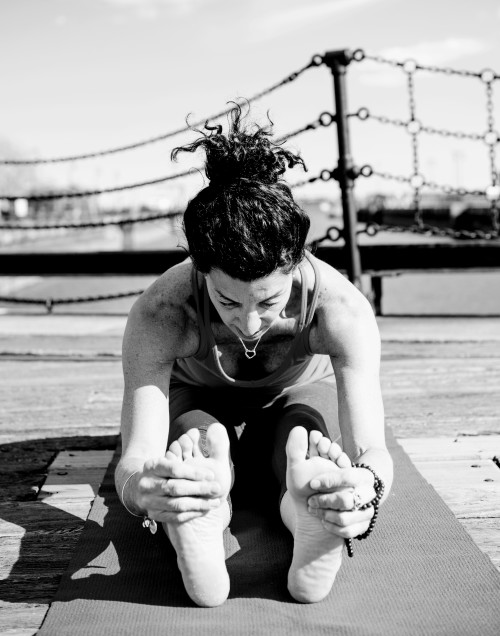
Let’s face it. Even the most avid student comes to class once a day. There are all those other hours of the day that they’re moving around, lifting things, running, walking, carrying bags, hunching over their computers… all actions that are having an impact (positive or negative) on their body.
One of my highest goals as a yoga teacher is to provide helpful information to my students as to how they can “take their yoga with them” as they’re moving around during their day. But what does this mean? You’ve probably heard this before and may have been wondering, “How am I supposed to do that?”
Let’s go over a few ideas:
- After you teach a few poses in the sequence, mention that these poses would be helpful to do when they wake up or after a run (or another idea that’s more applicable). We have to encourage our students to make yoga part of their “every day” versus something that only happens when they’re at the studio. For most of us, getting to the studio is more of an event rather than a regular part of our life; getting out of work, finding a parking space, getting someone to watch the kids, fitting it into our list of things to do.. it’s hard to find time for it. So, we need to help our students recognize that there are little pockets of time each day when they can practice a few poses.
You might say, “Well, what good is that? It’s not as helpful as taking a full class.” I always say that “a little yoga every day is better than a long practice once a week.” Sure, those longer practices at the studio are great. But regular strengthening and stretching done more consistently rather than once a week is better for the body. In this way, we start to build up muscle memory, we keep the joints supple, we keep the muscles moving in both directions, we take a few minutes to invest in our health and most importantly, we’re building a new healthy habit.
Students are also looking for quick sequence ideas. One of my biggest concerns from students is “I’d love to do a little yoga every day but I can’t think of what to do!” This is why I have my You Tube channel; I use it to post instructional videos and quick sequences. However, I also love to suggest after doing a few poses, ” This would be great to do in the morning,” for instance. A good general suggestion is to mention it after Sun Salutations. This series of movements is one of the most basic and fundamental but has tremendous benefits around strength, flexibility and cardiovascular health.
- As you bring up key anatomical actions, provide a movement example from “real life” that helps students see the “real life applicability.” Let’s look at the example of hunching over the desk and how this contributes to contracted pectoral muscles and overstretched rhomboids. As you take students through the action of interlacing their hands behind the back and adducting the shoulder blades (drawing the shoulder blades closer together), suggest that they do this several times throughout the day. This integration of “doing the opposite action” can provide muscles with the countermovement they need to stay balanced.
- Give them cues that share the benefit of the anatomical action as it relates to a common lifestyle action. This could be explaining that we are lengthening the Psoas when doing a pose like Bridge which is great for runners, or could be sharing a bit about how Toes Pose can also be helpful to runners who have plantar fasciitis. As they come into Locust Pose, explain how with the arms reaching forward (a variation of what’s pictured here), it’s a great way to strengthen the spine and the erector spinae muscles, which is a great way to counteract the negative effects of hunching.
- Encourage them to rest deeply at the end of their practice rather than move around. We all can relate to not having enough time to meditate and rest the mind. For our students, those 5 minutes at the end of yoga class is probably the only time all day they’ll be still. For many, this is challenging and as such, they fidget or take other yoga poses, finally settling in after 2 or 3 minutes of moving around. I get it; you’re feeling good and connected to your body so what’s the harm of a few more poses? I’d gently suggest that one of the best things you can do at the end of class is drop right into rest. Take the time to rest your body and mind. As a teacher, we can suggest that people try as much as possible to take just 5 minutes every day to rest their mind. This is different than sleep; it’s the intentional choice to mediate or take a 5 minute shavasana.
If you like learning the anatomy of yoga, you might be interested in my online course on moving from High to Low Push Up. It can be done in about an hour and is chock full of the anatomy, key actions and the cues you can use to teach your students how to do it correctly. It’s only $20 and you can get it here:
Moving from High to Low Push Up
If you’d like to download my free 3-PDF pack on different aspects of yoga anatomy, you can get it by just clicking the box below. Thanks for reading!
Interested in receiving a 3-PDF Teacher’s Yoga Anatomy Kit? Click here!

Thank you for sharing so generously. Your tips are so helpful.
Oh my goodness, my friend! Thanks for the comment. I am so glad you liked it! Thanks for letting me know : ) Karen